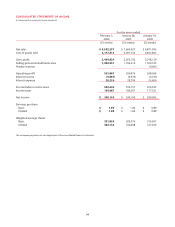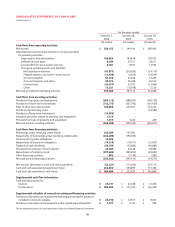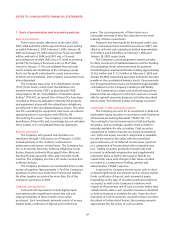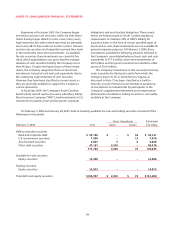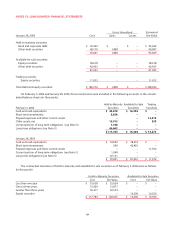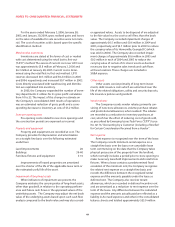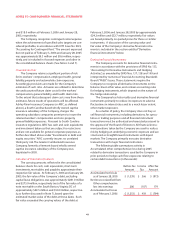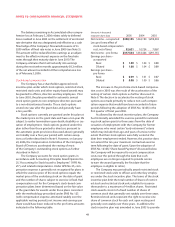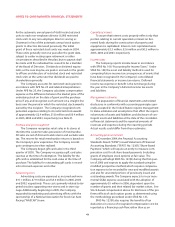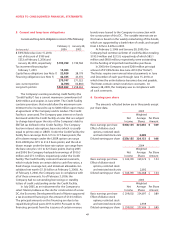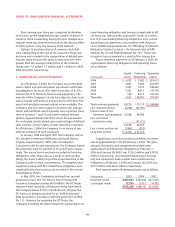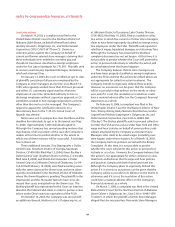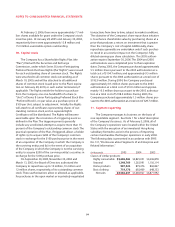Dollar General 2005 Annual Report Download - page 48
Download and view the complete annual report
Please find page 48 of the 2005 Dollar General annual report below. You can navigate through the pages in the report by either clicking on the pages listed below, or by using the keyword search tool below to find specific information within the annual report.
44
NOTES TO CONSOLIDATED FINANCIAL STATEMENTS
operating cash flow as required under current literature.
This requirement will reduce net operating cash flows
and increase net financing cash flows in periods after
adoption. While the Company cannot estimate what
those amounts will be in the future (because they
depend on, among other things, when employees
exercise stock options), the amounts of operating cash
flows recognized in the accompanying consolidated
statements of cash flows for such excess tax deductions
were $6.5 million, $9.7 million and $14.6 million for 2005,
2004 and 2003, respectively.
On January 24, 2006, the Compensation Committee
(“Committee”) of the Company’s Board of Directors
approved the acceleration of vesting for 6.4 million of the
Company’s outstanding stock options awarded prior to
August 2, 2005. The vesting acceleration was effective
February 3, 2006.Vesting was not accelerated for stock
options held by the CEO and stock options granted in
2005 to the officers of the Company at the level of
Executive Vice President or higher. In addition, pursuant to
that Committee action, the vesting of all outstanding
options granted on or after August 2, 2005 but prior to
January 24, 2006, other than options granted during that
time period to the officers of the Company at the level of
Executive Vice President or higher, accelerated effective as
of the date that is six months after the applicable grant
date. Certain options granted on January 24, 2006 to
certain newly hired officers below the level of Executive
Vice President were granted with a six-month vesting
period. The decision to accelerate the vesting of stock
options was made primarily to reduce non-cash compen-
sation expense that would have been recorded in future
periods following the adoption of SFAS No. 123(R) in the
first quarter of fiscal year 2006. This action is expected to
enable the Company to eliminate approximately $28 million
of expense, before income taxes, over the four year period
during which the stock options would have vested, subject
to the impact of additional adjustments related to the for-
feiture of certain stock options. The Company also believes
this decision benefits employees. In connection with the
acceleration and in accordance with the provisions of APB
25, the Company recorded compensation expense of $0.9
million, before income taxes, during 2005.
In March 2005, the FASB issued FASB Interpretation 47,
“Accounting for Conditional Asset Retirement Obligations”
(“FIN 47”), which is effective no later than the end of fiscal
years ending after December 15, 2005. This Interpretation
clarifies that the term conditional asset retirement obliga-
tion as used in FASB Statement No. 143,“Accounting for
Asset Retirement Obligations”, refers to a legal obligation to
perform an asset retirement activity in which the timing
and (or) method of settlement are conditional on a future
event that may or may not be within the control of the
entity. The obligation to perform the asset retirement activ-
ity is unconditional even though uncertainty exists about
the timing and (or) method of settlement. Thus, the timing
and (or) method of settlement may be conditional on a
future event. Accordingly, an entity is required to recognize
a liability for the fair value of a conditional asset retirement
obligation if the fair value of the liability can be reasonably
estimated. The fair value of a liability for the conditional
asset retirement obligation should be recognized when
incurred—generally upon acquisition, construction, or
development and (or) through the normal operation of the
asset. Uncertainty about the timing and (or) method of
settlement of a conditional asset retirement obligation
should be factored into the measurement of the liability
when sufficient information exists. Statement 143
acknowledges that in some cases,sufficient information
may not be available to reasonably estimate the fair value
of an asset retirement obligation.This Interpretation also
clarifies when an entity would have sufficient information
to reasonably estimate the fair value of an asset retirement
obligation. The Company adopted the provisions of FIN 47
during the fourth quarter of 2005, and such adoption did
not have a material impact on the Company’s consolidated
financial statements as a whole.
Reclassifications
Certain reclassifications of the 2004 and 2003
amounts have been made to conform to the 2005 presen-
tation.
2. Property and equipment
Property and equipment is recorded at cost and sum-
marized as follows:
(In thousands) 2005 2004
Land and land improvements $ 147,039 $ 145,194
Buildings 381,460 333,667
Leasehold improvements 209,701 191,103
Furniture, fixtures and equipment 1,437,324 1,196,094
Construction in progress 46,016 74,277
2,221,540 1,940,335
Less accumulated depreciation
and amortization 1,029,368 859,497
Net property and equipment $ 1,192,172 $1,080,838


